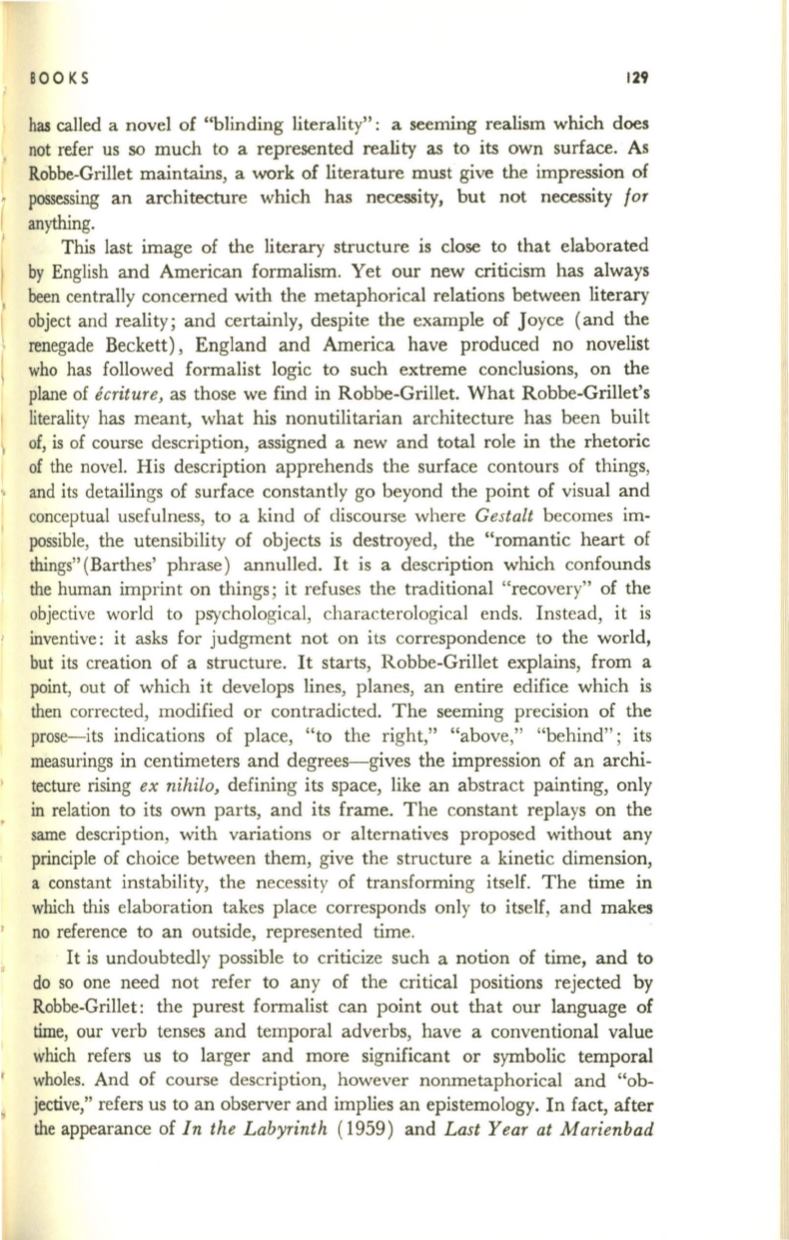
BOO KS
129
has
called a novel of "blinding literality": a seeming realism which does
not refer us so much to a represented reality as to its own surface. As
Robbe-Grillet maintains, a work of literature must give the impression of
possessing an architecture which has necessity, but not necessity
for
anything.
This last image of the literary structure is close to that elaborated
by English and American formalism. Yet our new criticism has always
been centrally concerned with the metaphorical relations between literary
object and reality; and certainly, despite the example of Joyce (and the
renegade Beckett), England and America have produced no novelist
who has followed formalist logic to such extreme conclusions, on the
plane of
ecriture,
as those we find in Robbe-Grillet. What Robbe-Grillet's
literality has meant, what his nonutilitarian architecture has been built
of, is of course description, assigned a new and total role in the rhetoric
of the novel. His description apprehends the surface contours of things,
and its detailings of surface constantly go beyond the point of visual and
conceptual usefulness, to a kind of discourse where
Gestalt
becomes im–
possible, the utensibility of objects is destroyed, the "romantic heart of
things" (Barthes' phrase) annulled. It is a description which confounds
the human imprint on things ; it refuses the traditional "recovery" of the
objective world to psychological, characterological ends. Instead, it is
inventive: it asks for judgment not on its correspondence to the world,
but its creation of a structure. It starts, Robbe-Grillet explains, from a
point, out of which it develops lines, planes, an entire edifice which is
then corrected, modified or contradicted. The seeming precision of the
prose-its indications of place, "to the right," "above," "behind"; its
measurings in centimeters and degrees-gives the impression of an archi–
tecture rising
ex nihilo,
defining its space, like an abstract painting, only
in relation to its own parts, and its frame. The constant replays on the
same description, with variations or alternatives proposed without any
principle of choice between them, give the structure a kinetic dimension,
a constant instability, the necessity of transforming itself. The time in
which this elaboration takes place corresponds only to itself, and makes
no reference to an outside, represented time.
It is undoubtedly possible to criticize such a notion of time, and to
do so one need not refer to any of the critical positions rejected by
Robbe-Grillet: the purest formalist can point out that our language of
time, our verb tenses and temporal adverbs, have a conventional value
which refers us to larger and more significant or symbolic temporal
wholes. And of course description, however nonmetaphorical and "ob–
jective," refers us to an observer and implies an epistemology. In fact, after
the appearance of
In the Labyrinth
(1959) and
Last Year at M arienbad


